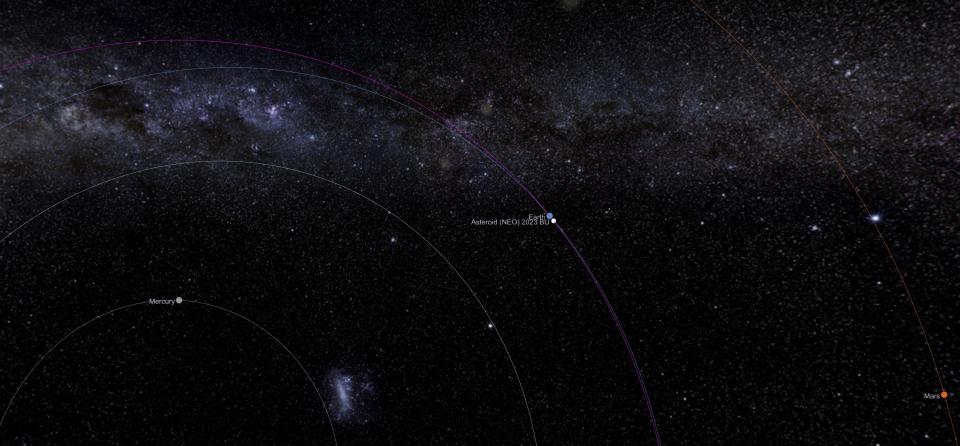An asteroid will pass close by Earth this week. Here's how to watch it live

A newly discovered asteroid will come very close to Earth this week.
Asteroid 2023 BU measures between 12 and 28 feet wide (3.8 to 8.5 meters), and was just discovered on Saturday (Jan. 21) by astronomer Gennadiy Borisov at the MARGO Observatory in Crimea. When it passes by Earth at its closest on Thursday (Jan. 26) at 4:17 p.m. EST (2117 GMT), the space rock will be within less than 3% of the average Earth-moon distance at an altitude of just 2,178 miles (3,506 kilometers) above Earth's surface.
For comparison, most geostationary satellites orbit at an attitude of around 22,200 miles (35,800 km).
Most asteroids aren't bright enough to be seen without a powerful telescope; luckily, you can watch asteroid 2023 BU make its close encounter with our planet thanks to the Virtual Telescope Project. Astronomer Gianluca Masi will be hosting a free livestream of the asteroid's pass on the project's website or YouTube channel on Thursday (Jan. 26) starting at 2:15 p.m. EST (1915 GMT).
Related: Asteroids: Fun facts and information about these space rocks

TOP TELESCOPE PICK:

Want to look up at Ursa Major and maybe catch a glimpse of asteroid 2023 BU? We recommend the Celestron Astro Fi 102 as the top pick in our best beginner's telescope guide.
The asteroid is currently in the Ursa Major constellation. Due to its small size, asteroid 2023 BU is fairly dim at magnitude 19.15, but it might be visible through a powerful telescope operated by a seasoned skywatcher.
Luckily for those of us who aren't veteran asteroid chasers, the Virtual Telescope Project will stream the whole thing. "Asteroid 2023 BU will have an extremely close, but safe, encounter with us, coming [within] less than 10,000 km from the Earth's center, about 25% of the geostationary satellites' distance," writes Masi on the project's website.
Asteroid 2023 BU is known as an Apollo-type asteroid, which means its orbit crosses that of Earth but spends most of its time well outside the path of our planet, according to the Center for Near Earth Object Studies, which is based at NASA's Jet Propulsion Laboratory in Southern California. 2023 BU orbits the sun every 425 days and will not pass close to our planet again until Dec. 6, 2036.
While asteroid 2023 BU will pass extremely close to Earth, it is not categorized as potentially hazardous. That's because its small size means it would likely break up and incinerate in Earth's atmosphere.
Hoping to catch a glimpse of asteroid 2023 BU? Our guides on the best telescopes and best binoculars might help you get started on the path to right optics. You can also check out our guides on the best cameras for astrophotography and best lenses for astrophotography to get started.
Editor's Note: If you manage to catch a photo of asteroid 2023 BU and would like to share it with Space.com’s readers, send your photo(s), comments, and your name and location to spacephotos@space.com.
Follow Brett on Twitter at @bretttingley. Follow us @Spacedotcom, or on Facebook and Instagram.

 Yahoo Autos
Yahoo Autos 